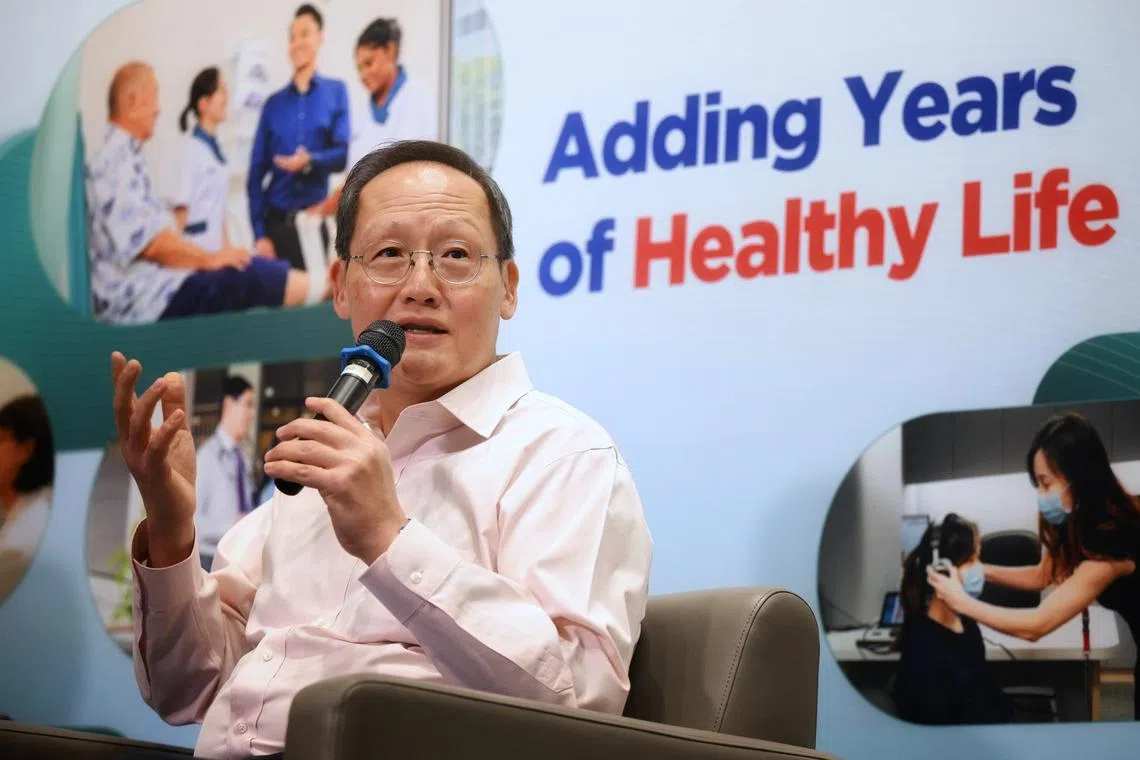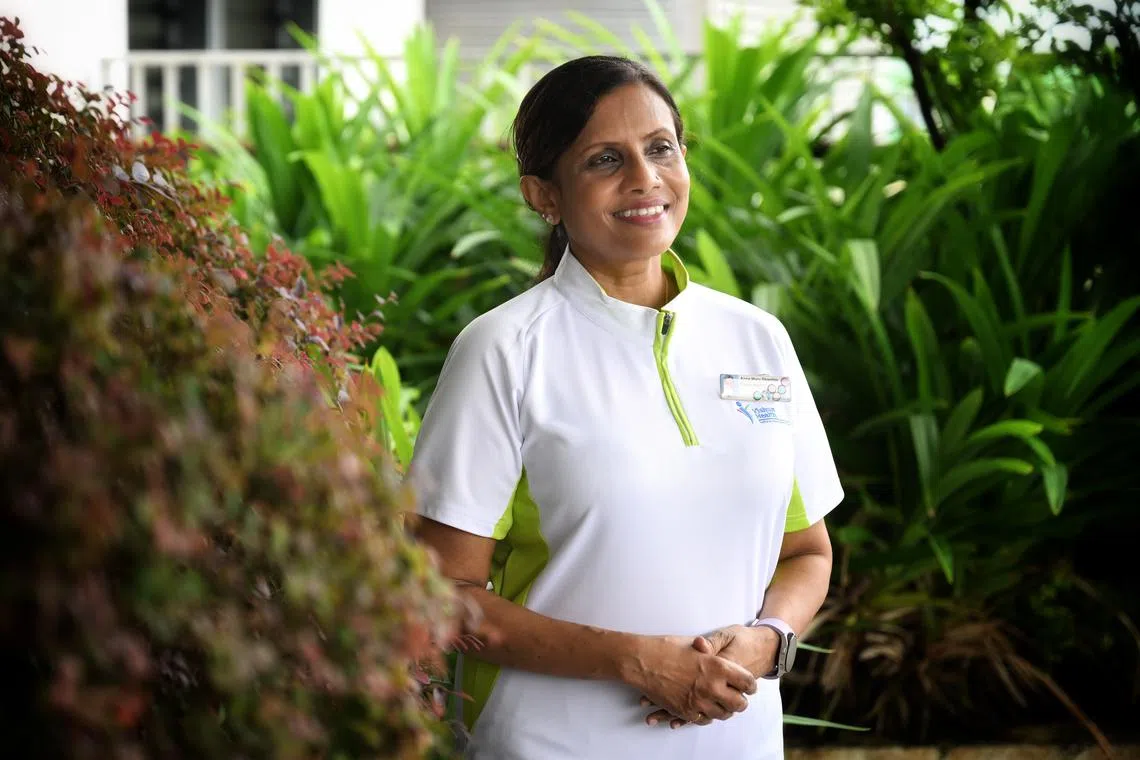Real median income in Singapore grew 3.4% in 2024, gap with lower-wage workers narrows: MOM
Sign up now: Get ST's newsletters delivered to your inbox
![CMG20241010-LimMS02/林明顺/张俊, 胡洁梅, 卢慧菁/Press Conference on National Wages Council Guidelines【Embargoed 10/10, 5pm】[MOM HQ, Havelock & New Market and Merchant Rooms, L7, Havelock Rd, S'059764]
Caption: Pictures of CBD office workers taken at around Tanjong Pagar during lunch hours on 10 Oct 2024.](https://cassette.sphdigital.com.sg/image/straitstimes/ab10ebeeffa8258a47bb77394bd90f7d0c70805d056438ae9f86c8dc2026e316)
The Ministry of Manpower said growth in absolute income numbers – coupled with easing inflation – drove the rebound.
PHOTO: LIANHE ZAOBAO
Follow topic:
SINGAPORE – Median- and lower-wage earners saw their incomes grow in 2024 after accounting for inflation, rebounding out of the negative range seen in 2023.
Early findings from annual data on the resident labour force, released by the Ministry of Manpower (MOM) on Nov 28, also show that the income gap between median- and lower-wage earners narrowed further.
Residents refer to those who are either citizens or permanent residents here.
Real income growth clocked in at 3.4 per cent for those who earn the median income, and 4.6 per cent for lower-wage earners at the bottom 20 per cent threshold, though these figures are preliminary as full-year inflation data is not yet available for 2024.
This comes after high inflation in 2023 eroded real income growth to minus 2.2 per cent for those at the median and minus 3 per cent for 20th-percentile earners.
MOM said growth in absolute income numbers – coupled with easing inflation – drove the rebound.
Before accounting for inflation, the median nominal income came in at $5,500 a month in 2024, up 5.8 per cent from 2023, while those at the 20th percentile drew $3,026, up 7.1 per cent.
The data is for residents in full-time employment and includes employer contributions to the Central Provident Fund.
The ministry noted the latest real income growth figures approach the average annual rates seen pre-pandemic from 2014 to 2019, which were 3.8 per cent for median income earners and 4.4 per cent per year for those at the 20th percentile.
“Income growth was also inclusive, with (20th-percentile) income growing faster than the median,” it said in its report.
In 2024, 20th-percentile wage earners earned 55 per cent of what median wage earners did, up from 52 per cent a decade ago, which MOM said attests to the closing income gap.
The ministry added that 20th-percentile wage earners can expect even greater increases in the coming years under the Progressive Wage Model (PWM).
The PWM is a wage ladder tied to skill and productivity improvements of lower-wage workers in seven sectors and two occupations currently, with wage floors at each rung increased according to a schedule.
In terms of five-year periods, real income growth for median earners slowed to 0.7 per cent annually for 2019 to 2024, from 3.8 per cent for 2014 to 2019. For 20th-percentile earners, they dropped to 1.2 per cent from 4.4 per cent over the same periods.
Nonetheless, Singapore outperformed many economies on real income growth from 2019 to 2024, including major advanced economies such as Britain, the United States and Japan, MOM said.
Meanwhile, nearly six in 10 of the full-time resident employees aged 25 to 64 who switched industries earned at least 5 per cent more in real terms, as they were generally hired into higher-skilled positions in more productive sectors such as financial and insurance services, as well as information and communications.
However, nearly two in 10 saw their real income decline by at least 5 per cent.
Mr Ang Boon Heng, director of MOM’s manpower research and statistics department, said these workers could have chosen to switch to lower-paying roles for more work-life balance or to take up place-and-train programmes with a lower pay initially, among other factors.
The rest of the workers had new incomes within 5 per cent lower or higher in real terms.
Amid a tight labour market, the unemployment rate as at June 2024 was 2.7 per cent for professionals, managers, executives and technicians (PMETs) and 3.4 per cent for non-PMETs, before seasonal adjustment.
The employment rate of people with disabilities aged 15 to 64 has risen steadily to 33.6 per cent in 2024, up 0.9 percentage point from a year ago, and over 5 percentage points higher than 2019’s figure.
The ministry’s Nov 28 report noted that time-related underemployment in 2024 stayed at a low rate of 2.3 per cent, the same as in 2023. But it crept up for certain groups of workers, such as those in professional services, administrative and support services as well as arts, entertainment and recreation.
Meanwhile, with fewer taxi drivers and private-hire car drivers in 2024, the number of regular platform workers declined to 67,600, or 2.7 per cent of all employed residents. In 2023, there were 70,500 regular platform workers, which was 2.9 per cent of all employed residents.
Ageing population may increase strain
Overall, the labour force participation rate of residents aged 15 and over declined for the third consecutive year, to 68.2 per cent in 2024. This rate refers to the proportion of those in that age range who are either employed or available for work and looking for a job.
MOM said: “While participation rose in most age groups, the growing share of seniors, who have lower participation rates, contributed to this decline.
“With the population ageing, this trend is expected to limit workforce growth.”
It added that the figure peaked in 2021 amid an uptake of temporary pandemic-related jobs such as safe distancing ambassadors, but is still higher than in cities such as Tokyo, Helsinki, Berlin and Hong Kong.
MOM’s report also included data on the resident old-age support ratio.
This is the number of residents aged 20 to 64 for each resident aged 65 and above, which MOM said provides a rough indication of the number of people “who are potentially economically and socially supporting elderly people”.
The ratio has almost halved from six in 2014 to 3.5 in 2024, with a further decline to 2.7 in 2030 projected.
The ratio rises to five in 2024 if foreign workers are included, a fact that Minister for Manpower Tan See Leng said underlines why Singapore has to take the “very pragmatic approach” of remaining open to complementary foreign workers to maintain support for its ageing population.

Minister for Manpower Tan See Leng during a Q&A session with the media on the ministry’s latest labour force data, at Yishun Community Hospital on Nov 28.
ST PHOTO: CHONG JUN LIANG
Speaking to reporters during a visit to Yishun Community Hospital (YCH) on Nov 28, Dr Tan said the Government will continue to support seniors who are willing and able to remain in the workforce.
But he noted that the growing size of retiring cohorts and proportion of those who have met or surpassed their CPF retirement sums could make spending more time with the family, or working “more leisurely”, an attractive option for more seniors, despite the work support in place.
When asked if the Government will plan foreign workforce policies around spreading out the tax burden, on top of skills needed, Dr Tan said the local workforce must stay competitive in its own right, even as foreigners are roped in to help create jobs, fill shortages and share the tax burden.
“What we are now doing is to ensure that we continue to be self-sufficient, and the self-sufficiency has to come from a very comprehensive holistic approach towards our ageing workforce,” he added.
He cited YCH’s example of hiring senior workers and career switchers as good workplace practices.
Its chief executive, Professor Chua Hong Choon, who also helms Khoo Teck Puat Hospital, said the two hospitals have together hired more than 20 people aged above 55 over the last two years.
“The more senior and experienced people are also able to connect with our patients on a different level, and they complement... young healthcare workers,” Prof Chua said.
Madam Anne Mary Shantini V.S. Light, 61, who has worked as a therapy assistant at YCH since 2019 after completing a course at healthcare training organisation HMI Institute, is one such worker.

Madam Anne Mary Shantini V.S. Light has worked as a therapy assistant at YCH since 2019 after completing a course at healthcare training organisation HMI Institute.
ST PHOTO: CHONG JUN LIANG
She switched to healthcare after working in childcare for eight years, following 15 years as a housewife, as she wanted to “keep up and keep active”.
And while it was challenging for her to learn how to use the computer for work initially, she said with a smile: “My younger colleagues are always willing to help me.”

